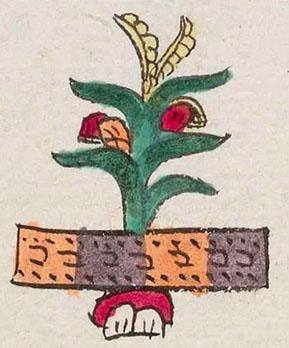Chinantlan (Mdz46r)
This compound glyph for the place name Chinantlan has a focus on the chinamitl (today called the chinampa in Mexican Spanish and in English). The chinampa is an agricultural strip of land. Here it is horizontal and segmented, with alternating colors of purple and orange (or a terracotta color). It has dots and sideways u's or backward c's, suggesting cultivation. Above this chinampa is a maize plant painted a two-tone green, with five large leaves or branches, a two-part, yellow flower at the top, and two ears of corn in the middle, one on each side. The corn cobs are red with a white tassel and terracotta-colored with a red tassel. Below the parcel are two front teeth (tlantli), white with red gums, providing the phonetic element for the locative suffix -tlan, near.
Stephanie Wood
The maize plant here is a testimonial of the fertility of chinampas. It does not have a phonetic role in this glyph, only iconographic. It is very typical to have the colors of the cobs vary, usually one yellow, one red, with contrasting colors for tassels. It is also customary to find the two hash marks on the cobs, possibly making them face-like. See below, right, for other maize plants that do enter into place names.
Chinampas were an especially popular type of agriculture around the lakeshores of the basin of Mexico. They are still found in Xochimilco and San Gregorio Atlapulco, among other places at the southern end of Mexico City. Mud from the lake bottom would be piled onto the plots, and the sides of the plots were reinforced with fencing.
Below, right, we show how the plots of the chinamitl (stem: chinan-) look very much like the tlalli, milli, and even the ixtlahuatl.
The locative suffix -tlan does not imply abundance the way the -tla (or -tlah, showing the glottal stop) would. It is just "place," as Karttunen points out. The gloss shows that this particular place name ends in -tlan, as does the visual teeth in the glyph.
The visual representation of the tlantli (tooth, teeth) here is the most popular--two, upper, front teeth. But they can be bottom teeth (or inverted), and they can include upper and lower teeth, both inside and sticking out from another element. See below, right, for a few examples.
Regarding the interpretation about the Chinanteca, I believe the -teca postposition would come from Chinantlan, not the other way around. In other words, the Chinanteca are the people of Chinantlan. For another glyph for Chinantlan (unclear whether it is the same place or not) see below.
Stephanie Wood
chinantlan. puo
Chinantlan, pueblo
Stephanie Wood
c. 1541, but by 1553 at the latest
Stephanie Wood
chinampas, parcels, farming, agriculture, agricultura, milpa, maíz, parcelas, nombres de lugares

chinami(tl), a reed or cane fence or enclosure, https://nahuatl.wired-humanities.org/content/chinamitl
tlan(tli), teeth, https://nahuatl.wired-humanities.org/content/tlantli
-tlan (locative suffix), place, https://nahuatl.wired-humanities.org/content/tlan
"Chinampa Place" [Frances Karttunen, unpublished manuscript, used here with her permission.]
"Where There are Many Chinanteca" (Berdan and Anawalt, 1992, vol. 1, p. 178)
Codex Mendoza, folio 46 recto, https://digital.bodleian.ox.ac.uk/objects/2fea788e-2aa2-4f08-b6d9-648c00..., image 102 of 188.
The Bodleian Libraries, University of Oxford, hold the original manuscript, the MS. Arch. Selden. A. 1. This image is published here under the UK Creative Commons, “Attribution-NonCommercial-ShareAlike 3.0 License” (CC-BY-NC-SA 3.0).








